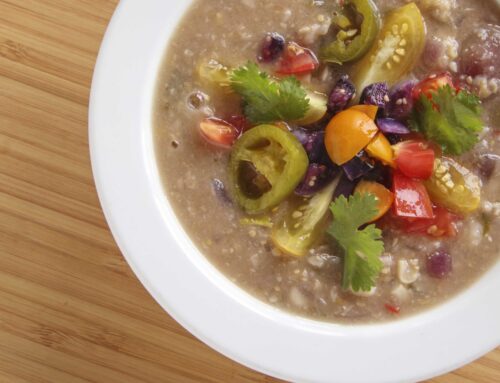
An easy way to get started with raw food menu planning is to create and rotate a dozen or so raw vegan menus, based on family preferences. These core raw food recipes and menus can vary—for example, seasonal ingredients can be replaced by ingredients readily available all year. Most families enjoy the same ten or twelve familiar meals and appreciate knowing what to look forward to! A set of rotating favorite menus takes much of the guesswork out of meal planning, and helps you establish a rhythm, which is especially important in preparing raw food, as some raw food recipes use ingredients that need to be soaked, sprouted or dehydrated.
It may take a little time to organize twelve menus, but once mastered, they become a solid base that you’ll get better and better at preparing as time goes by. When you’re inspired to try new dishes, be sure to set some creative time aside on a day when your schedule is free. It’s fun to explore new menu ideas – anything from a favorite cooked dish that you can “translate” into a raw food dish, to special occasion menus for family celebrations.  When choosing a theme for a menu, keep in mind what’s in season, family preferences, and what’s currently available at farmer’s markets, in the garden, or at your local organic supermarket or co-op. Sometimes you might find just the perfect seasonal vegetable and want to plan an entire meal around it – succulent, perfectly ripe, colorful produce can be a real inspiration. One important tip when planning raw food menus is:
When choosing a theme for a menu, keep in mind what’s in season, family preferences, and what’s currently available at farmer’s markets, in the garden, or at your local organic supermarket or co-op. Sometimes you might find just the perfect seasonal vegetable and want to plan an entire meal around it – succulent, perfectly ripe, colorful produce can be a real inspiration. One important tip when planning raw food menus is:
“Make green your favorite color!”
It’s always important to choose the freshest, ripest, most nutrient-dense organic ingredients available, while limiting fats and salt. Dark green leafy vegetables definitely pack a nutritional wallop, and can be included in every health conscious meal. Balancing flavors, texture and appearance is as important in raw foods as it is in any type of menu planning; making meals that are easy to digest and contain an abundance of valuable nutrients required for optimal health, means that raw food chefs have an extra element of responsibility when planning a menu.
Remember to balance rich foods with lighter ones, and to keep fat to less than 30% of the meal’s calories. Flavors should build in the menu, and simple preparations are often the most appreciated. The more raw food you eat, the more you will appreciate very simple, basic combinations, optimized for digestion with proper food combining. Color is another important factor in raw foods. Luckily, fruits and vegetables come in all colors of the rainbow, which adds not only to variety in a meal, but an abundance of phytonutrients that are uniquely available in each color! If you’d like to learn more about creating recipes and menu planning, we’ve got a great deal on both our Gourmet and Platinum Package. Both packages include our advanced recipe development classes. Click here to learn more! We’ll take your raw food education to the next level.
Be sure to keep your prep time realistic by making your menu manageable. One gourmet item per meal is probably enough to satisfy the palate, and keep overeating to a minimum. Contrast textures—like serving a creamy dip paired with a crispy cracker, and be sure to include a range of all five flavors in your menu: sweet, salty, sour, bitter, and pungent, and compliment strong flavored dishes with milder ones. Enjoy the process of working with nature’s bounty and providing your family (and friends) with nutritious meals that taste delicious and contribute to health, and always prepare each meal with LOVE!








